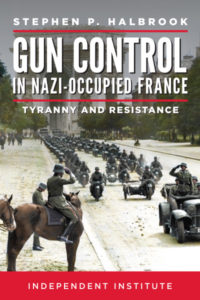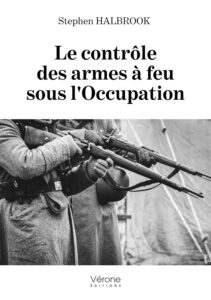
Gun Control in Nazi-Occupied France:
Tyranny and Resistance
by Stephen P. Halbrook
Published by The Independent Institute (2018)
TRANSLATION
SUMMARY
Nazi Germany invaded France in 1940. In every occupied town, Nazi soldiers put up posters that demanded that civilians surrender their firearms within twenty-four hours or else be shot. Despite the consequences, many French citizens refused to comply with the order. In Gun Control in Nazi-Occupied France: Tyranny and Resistance, Stephen P. Halbrook tells this story of Nazi repression and the brave French men and women who refused to surrender to it.
Taking advantage of a prewar 1935 French gun registration law, the Nazis used registration records kept by the French police to easily locate gun owners to enforce their demand that firearms be surrendered. Countless French citizens faced firing squads for refusing to comply. But many French citizens had resisted the 1935 decree, preventing the Nazis from fully enforcing the confiscation order. Throughout the Nazi occupation, the French Resistance grew, arming itself to conduct resistance activities and fight back against the occupation.
Drawing on records of the German occupation and testimonies from members of the French resistance, Gun Control in Nazi-Occupied France is the first book to focus on the Nazis’ efforts to disarm the French.
CONTENTS
Introduction
- Crisis in the Third Republic
- Pierre Laval Decrees Firearm Registration
- Blitzkrieg, Defeat, and Twenty-Four Hours to Turn in Your Gun or Be Shot
- Occupation and Collaboration
- Weapons Possession: The Core of Criminal Activities of the French
- Amnesty or Execution
- Arms for the Resistance
- Liberation
Concluding Thoughts
NOTEWORTHY REVIEWS
“The theme of Gun Control in Nazi-Occupied France is new, and Stephen Halbrook conveys it with laudable precision. In the early 1980s, I spoke to French Resistance fighters who told me how difficult it was to hide weapons during the German occupation. But never before had I read anything about it. We owe Halbrook tremendous gratitude for illuminating a crucial issue that had not been addressed by either the Germans or the French.”
—WIELAND GIEBEL, Founder and Curator, Berlin Story Museum, Germany; author, The History of Berlin, The Brown Berlin, Goebbels’s Propaganda, and Hitler’s Terror in Berlin
“In the outstanding book, Gun Control in Nazi-Occupied France, Halbrook shows that although the French government did not intend to disarm the population when it mandated the registration of firearms, the very existence of registration records made it possible for the Nazis who occupied France during WWII to tighten their bloody grip on the country by hunting down gun owners. The applicable lesson here is that the intentions behind gun control measures aimed at the general population don’t matter as much as the inevitable result: subtracting from the people’s power to guard their own freedom. His mixture of anecdotes and statistics makes for sobering reading.”
—ANGELO M. CODEVILLA, Professor Emeritus of International Relations, Boston University; author, Informing Statecraft, War: Ends and Means (with Paul Seabury), The Character of Nations, and Between the Alps and a Hard Place: Switzerland in World War II and the Rewriting of History
“Did France’s gun control hurt its resistance to the Nazis? A new book by a prominent Second Amendment lawyer examines the history. The French came closer to having a Second Amendment than one might imagine. Indeed, they could have had one more clearly written than ours: Just a month after the storming of the Bastille in 1789, a draft of the Declaration of Rights stated that ‘every citizen has the right to keep arms at home and to use them, either for the common defense or for his own defense, against any unlawful attack which may endanger the life, limb, or freedom of one or more citizens.’ Alas, it was not to be. That provision did not make it into the final document, though a vague right to ‘resistance of oppression’ did. Renowned Second Amendment lawyer Stephen Halbrook detailed this history in a 2012 article for the Fordham Urban Law Journal. And now, in his book Gun Control in Nazi-Occupied France, he explains how French gun policy evolved over the centuries—and the consequences it had under the Nazi-puppet Vichy regime during World War II. A sequel of sorts to Halbrook’s Gun Control in the Third Reich, the book drives home the important lessons that gun control is a key element of the oppressor’s toolkit, that guns are incredibly useful for those resisting oppression, and that even the most draconian gun-control measures are far from perfectly effective. It cannot prove, of course—and doesn’t purport to—that a stronger French tradition of gun rights could have radically altered history, or that America’s more libertarian gun policies strike the right balance among all the relevant priorities. What it does do is force readers to entertain a simple question: When a hostile and brutal power takes over, do you want your countrymen to have guns at hand, or not? Certainly this question weighed heavily upon the minds of the American Founders, and certainly its answer counts for something. . . . Gun control is not inherently a tool of oppression, but it is certainly useful to oppressors. And those who scoff at the notion that civilian gun owners can aid the fight against tyranny would do well to consider the evidence that Halbrook has marshaled here.”
—NATIONAL REVIEW (full review)
“Gun Control in Nazi-Occupied France is an impressive addition to the already vast literature on the Second World War. The book is filled with useful information from primary sources, much of it previously unpublished. Halbrook vividly depicts the terrible years of the occupation of France by German armed forces, in particular from the viewpoint of French owners of firearms, mainly hunting weapons but also miscellaneous military arms retained by the families of soldiers in prior wars. One of Hitler’s major objectives was to see France (and other conquered territories) completely firearms-free, and major efforts to this end were expended by the German armed forces and their French collaborators. Two aspects of Halbrook’s story are of obvious relevance for contemporary debates about civilian possession of firearms. First, although the Germans collected truckloads of firearms from all over France, they didn’t get all of them—or even, perhaps, most of them. Despite threatening the most draconian penalties (including the death penalty, which was carried out in thousands of instances), and despite unlimited powers to search any premises at any time without giving reasons, occupation authorities simply could not successfully disarm a population that was unwilling to cooperate with them. Second, many of the guns that remained in civilian hands found their way to the Resistance, which valued handguns in particular. It is not that people with side arms could credibly threaten to take on organized formations of the German army. But as Halbrook shows, guns played an indispensable moralizing role for the Resistance. Because its members were able to arm and protect themselves, the Resistance was able to survive and grow, and as it grew stronger it did play an increasingly important role in harrying occupation forces, providing vital intelligence to the Allied armies, and preparing the ground for Europe’s eventual liberation.”
—DANIEL D. POLSBY, Professor of Law, Antonin Scalia Law School, George Mason University


